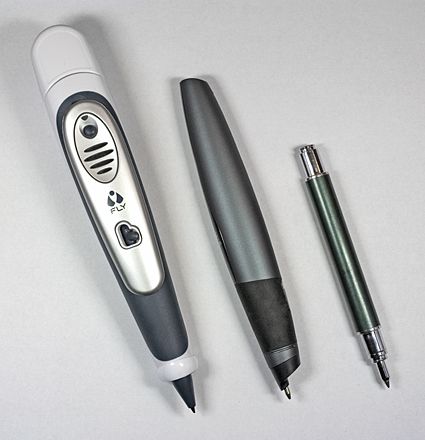Are Pens The Hot New Mobile Computing Technology?
Barry Gerber
On The Downside
No technology is perfect and pen-based computing has its downside too. The pens are larger than standard writing pens, Anoto pattern-based paper for them is expensive and you have to write clearly for characters to be correctly recognized.

From left to right: LeapFrog Fly, Logitech io2 and Schmidt ink cartridge-based writing pen.
The table below shows the size of three different pens: the Fly, Logitech's io2 and a plain old writing pen based on the ever popular Schmidt ink cartridge . The Fly with its more complex software, built-in speaker and support for earbuds as well as plug-in application cartridges is the largest. Additionally I expect that the Fly was deliberately oversized to make it easier for smaller fingers to manipulate it. Logitech's io2 pen is second largest and my favorite plain old Schmidt cartridge-based ink pen is the smallest. In spite of their larger sizes, the Fly and io2 are still surprisingly easy to hold and use.
Length Without Cap Where One Exists Width Depth Circumference Where Fingers Hold Pen
| Fly |
7" (178mm) |
1" (25.4mm) |
1.25" (31.75mm) |
2.69" (68.33mm) |
| io2 |
5.75" (146mm) |
.75" (19.75mm) |
.875" (22.23mm) |
2.25" (57.1mm) |
| Plain Ink Pen |
4.3" (109.22) |
.44" (11.18mm) |
.44" (11.18mm) |
1.63" (41.4mm) |
A notebook of 80 or so 8.5" x 11" Anoto pages sells for around $10 US. Two factors push the price up: Anoto's licensing fees and the complexities of managing and printing each sheet of paper with the Anoto pattern. If and as R&D costs are absorbed by increasing sales it's likely that paper prices will come down.
When it comes to recognizing characters, the Fly is pretty forgiving about how or where characters are written. As might be expected of a pen for children, it handles a pretty wide range of handwriting styles, but you must use uppercase letters. The Fly doesn't force you to write in the kinds of little rectangles you find on many character recognition forms. The spacing between lines on Fly Paper is .375" (9.53mm). Logitech's io2 pen is more demanding. You have to train it to read your handwriting and, as noted above, you have to write pretty neatly. Like the Fly, the io2 also works only when you use uppercase letters. Lines on Anoto paper for the io2 are .25" (6.35mm) apart. Some applications require you to write in boxes .125" (3.18mm) wide by .25" (6.35mm) high.
You really can't fault Logitech and its partners for their strict handwriting standards or for requiring training to the user's handwriting. After all a medical prescription is a life and death matter compared to playing a little music on a hand drawn keyboard.
Conclusions
The pen may be mightier than the sword, but it's also a pretty old piece of technology . Pen-based computers meld together the ancient and the modern to produce devices that operate in a familiar way while delivering significant computing power. They should not be overlooked as we search for the best ways to do our daily work and have our daily play.
Pen computing based on paper printed with the Anoto pattern holds a great deal of promise. Early applications for devices from various manufacturers are impressive. LeapFrog's Fly Pentop Computer uses the Anoto technology with more innovative panache than any other device to date. Built-in applications run smoothly, accurately and quickly. The Anoto pattern-based paper is used creatively to allow for a great deal of flexibility when creating an application and running it. The computer's unique expandability using application cartridges further enhances the cache and desirability of the Fly.
1 2